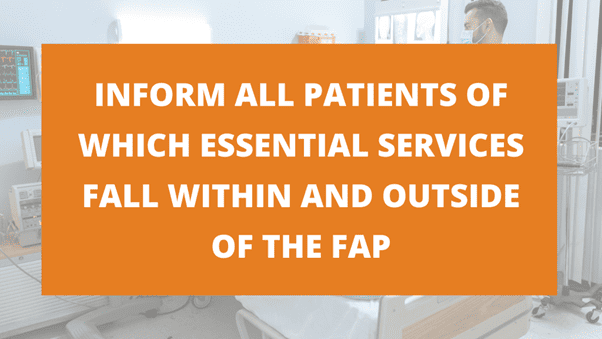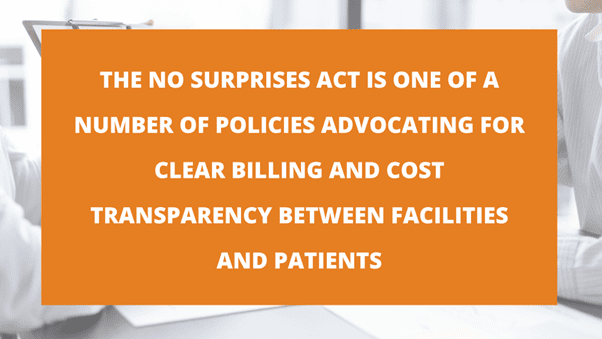Why a Financial Assistance Policy (FAP) is Critically Important!
A healthcare facility’s Financial Assistance Policy (FAP) is designed to provide clear access to discounted or free care for those that need financial assistance to access vital healthcare. The policy is designed to both make patients aware of any assistance that they are entitled to receive and also to ensure a consistent quality of service and level of transparency across the sector. And becoming FAP compliant is vital for all healthcare facilities.
What is a Financial Assistance Policy (FAP)?
According to the IRS, a FAP must apply to any emergency or essential medical care in a hospital facility or related medical entity. A written Financial Assistance Policy (FAP) must be widely publicized and include the following key information.
- Any and all eligibility criteria for financial assistance, and the type of care (free/discounted) to be provided.
- The medical facility’s basis and process for calculating charges to patients.
- How patients can apply for and access financial assistance including specific directions to access the financial support.
- The actions that may be taken in the event of nonpayment for a facility which does not have separate billing and collections policies.
- A comprehensive list of any other providers who are delivering emergency or other medically necessary care in the hospital facility. It must also outline which providers are and which are not covered by the FAP.
What Does It Mean to Widely Publicize an FAP Policy?
A hospital must make its FAP widely known to the population it serves by making the FAP, the FAP application form, and the plain English description of the FAP publicly available on the internet. The link should be clearly visible and all information should be easily accessible. Those with internet access should be able to access and download a copy of the document without needing any special software or hardware. Facilities must also provide a clear URL or link to the document when requested.
The facility must also make paper copies of the FAP documents available by mail and in public areas of the healthcare institution, including, as a minimum, the emergency room and any admissions areas. The FAP must also be available on request and without charge.
The facility should notify the community serviced by the facility about the FAP in a “reasonable manner” to reach those members of the community most likely to require financial help, as well as clearly notify and inform visitors to the hospital facility about the FAP. The facility must also cater to widely spoken non-English languages and make accessible copies of any documentation for communities speaking those languages. Groups serviced by the facility with over 1000 people, or those that make up more than 5% of the total serviced community are included and must be provided with suitably accessible copies of the FAP.
How Do Patients Benefit From an FAP?
The outlined features of the policy help patients understand what support is available to them. Hospitals are required to have all of the correct signage and website postings, provide clear versions of policies and make reasonable efforts to ensure eligible patients are aware of any support that they can receive.
i3solutions helps healthcare facilities with compliance through essential systems updates, automation, and where necessary, consulting. By creating IT systems that are more efficient and automatically flag necessary compliance actions, hospitals can reduce admin-related human error and provide better care for patients whilst ensuring FAP compliance.
What is Section 501(r)?
Section 501(r) was originally introduced as part of the Affordable Care Act in 2010 to help provide affordable care by imposing regulations on nonprofit hospitals. Three of the policies are related directly to the revenue cycles of hospitals, and failure to comply can result in facilities losing their tax-exempt status.
Key Section 501(r) Policies to Become FAP Compliant:
1. Facilities must establish a written Financial Assistance Policy (FAP)
The written FAP should include all necessary details previously outlined, including a plain-English version of the policy. Plain English means that readers should be able to understand all language and what the policy is trying to communicate after reading it just one single time. This makes policies accessible to patients and ensures that all staff in medical facilities can understand the FAP and can easily communicate it to patients when trying to establish eligibility.
2. They should set limits for FAP-eligible patients
This means that bills to FAP-eligible patients should not differ from or exceed bills sent to patients whose insurance is covering the cost of their medical care. As well as this, charges for other medical care provided to FAP-eligible patients must be less than the gross charges, or the CDM rate, for that care.
3. Facilities should make a reasonable effort to determine FAP eligibility
Section 501(r) also requires healthcare facilities make reasonable efforts to determine the FAP-eligibility of patients before they are able to make any extraordinary collection actions (ECAs) to attempt to recoup the debt. These reasonable measures include notifying patients both 120 days and 30 days prior to taking any ECAs as well as clearly providing the FAP online for patients to access during or after emergency treatment. The hospital is also responsible for making any debt collectors aware of the FAP and any necessary ways it is made accessible to patients.
How Does Being FAP Compliant Improve People’s Lives? Transparency!
The FAP is yet another measure in place to help improve transparency and assist patients with accessing fair and clearly billed medical care. Much like The No Surprises Act, an FAP provides instructions for medical facilities and puts clear guidance in place to ensure a consistent standard of care across the entire sector.
An FAP allows patients to access free or discounted emergency medical care and helps provide a higher level of essential care across the US for patients. Not knowing how they are going to pay essential medical bills can be a huge source of stress. Luckily, policies like an FAP remove many of these worries and open clear communication channels between facilities and those receiving care that can allow for dialogue about options and the cost of treatment.
Become FAP Compliant
At i3solutions, we help organizations merge host of compliance-related and technology services. To help your facility become FAP compliant, we can coordinate and prepare the correct signage and website materials, provide staff training, recommend legal experts, and connect your various IT systems and perform custom software development to help ensure you are using technology to it’s fullest to ensure everything falls within compliance.
Alongside this, we can assist healthcare facilities with reducing healthcare waste, fraud and abuse in facilities with software analytics as well as integrate with your revenue cycle management programs to help billing systems more simple for staff while ensuring compliance with regulations and policies.
IT Services and Software Development in Healthcare
Healthcare is an essential and core part of our day-to-day lives, but it can also be complex. We help organizations make the most of their internal IT systems to stay compliant, remain efficient and, most importantly, keep providing vital care to our communities.
If you’d like to discuss how we can help your facility use software development and integration to create better systems to help improve patients lives, get in touch today for a no-obligation call about how IT and compliance policoes such a FAP can work for you.
Leave a Comment





